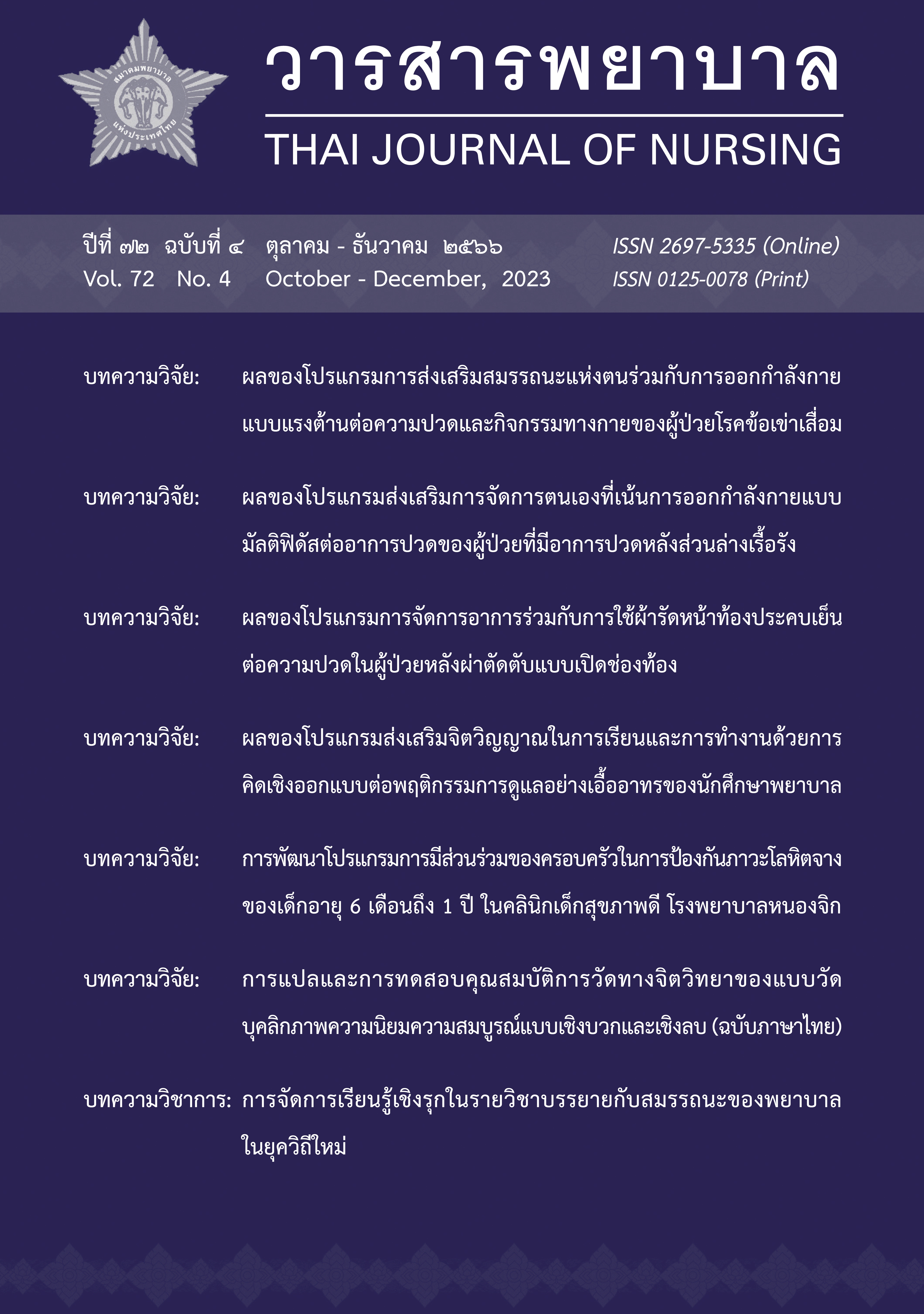The effect of self-management program emphasizing multifidus exercise on pain among patients with chronic low back pain
Main Article Content
Abstract
This quasi-experimental research aimed to determine the effect of self-management program emphasizing multifidus exercise on pain among patients with chronic low back pain. The subject were patients with chronic low back pain for more than 3 months, aged 20-59 years, visit to the orthopedic out-patient clinic in Chonburi Hospital. They were purposively selected and equally divided into the experimental and control groups. The control group received normal nursing care while the experimental group received self-management program emphasizing multifidus exercise for 6 weeks. Research tools were personal data and the Short Form McGill Pain Questionnaire (SFMPQ). The reliability (Cronbach’ alpha coefficient) of SFMPQ was 0.70. Data were analyzed using descriptive statistics, and t-test. The result show that 1) patients with chronic low back pain, after received self-management program emphasizing multifidus exercise, the pain score was significantly lower than the pre-program (p < .05). 2) Patients with chronic low back pain, after received self-management program emphasizing multifidus exercise, the pain score was significantly lower than the control group which received normal nursing care (p < .05).
Article Details

This work is licensed under a Creative Commons Attribution-NonCommercial-NoDerivatives 4.0 International License.
References
กิ่งแก้ว ปาจรีย์. (2564). ปวดกระดูกและกล้ามเนื้อ การบำบัดรักษาทางเวชศาสตร์ฟื้นฟู. ภาควิชาเวชศาสตร์ฟื้นฟู คณะแพทยศาสตร์ศิริราชพยาบาล มหาวิทยาลัยมหิดล.
เฉลิมรัฐ มีอยู่เต็ม. (2563). การศึกษาความชุกและปัจจัยที่เกี่ยวข้องกับอาการปวดหลังส่วนล่างของบุคลากรทางการพยาบาลในโรงพยาบาลนครปฐม. วารสารแพทย์เขต 4-5, 39(4), 578-590.
เดชวิน หลายศิริเรืองไร, ศิริวรรณ ยศสูงเนิน, วรวรรณ เอกบุตร, และ ประเสริฐ สกุลศรีประเสริฐ. (2563). ความสัมพันธ์ระหว่างความผิดปกติการเคลื่อนไหวของหลังส่วนล่างและการจำกัดพิสัยการเคลื่อนไหว. ศรีนครินทร์เวชสาร, 35(5), 545-551.
ธีรศักดิ์ พาจันทร์ และ เพชรรัตน์ สุขสลุง. (2563). ความชุกและปัจจัยที่มีความสัมพันธ์กับการปวดหลัง ส่วนล่างของบุคลากรสาธารณสุข สำนักงานสาธารณสุขจังหวัดขอนแก่น. วารสารวิชาการสาธารณสุขชุมชน, 6(3), 196-205.
พัชรินทร์ น้อยสุวรรณ, วีระพร ศุทธากรณ์, และ วันเพ็ญ ทรงคำ. (2562). ผลของโปรแกรมโรงเรียนปวดหลังต่ออาการปวดหลังส่วนล่าง และความสามารถในการปฏิบัติหน้าที่ของเกษตรกรชาวนา. พยาบาลสาร, 46(3), 142-156.
มนัส รงทอง, อัมรินทร์ คงทวีเลิศ, ดุสิต สุจิรารัตน์, และ เพชรรัตน์ ภูอนันตานนท์. (2562). ความชุกของอาการผิดปกติทางระบบกล้ามเนื้อและกระดูกโครงร่างในแรงงานใหม่เก็บเกี่ยวปาล์มน้ำมัน. วารสาร มฉก. วิชาการ, 23(1), 77-92.
รุจาธร อินทรตุล, วันชัย เลิศวัฒนวิลาศ, เบญญาภา พรมพุก, อภิชาติ กาศโอสถ, และ วิไลลักษณ์ วงศ์ เจริญ. (2563). ปัจจัยทำนายการจัดการตนเองในผู้ที่ปวดหลังเรื้อรัง. พยาบาลสาร, 47(4), 472-484.
ลินดา อ่องนก และ สุรีพร ธนศิลป์. (2565). ผลของโปรแกรมการจัดการตนเองที่เน้นการออกกำลังกายแบบแกว่งแขนต่อระดับฮีโมโกลบินเอวันซีของผู้ป่วยโรคเบาวหวานเข้าจอประสาทตา. วารสารพยาบาลศาสตร์ จุฬาลงกรณ์มหาวิทยาลัย, 34(3), 1-14.
วสุวัฒน์ กิตติสมประยูรกุล, จักรกริช กล้าผจญ, และ อภิชนา โฆวินทะ (2547). แบบประเมินความเจ็บปวด Sort-form McGill Pain Questionnaire ฉบับภาษาไทย. เวชศาสตร์ฟื้นฟูสาร, 14(3), 83-93.
สุกัญญา อังศิริกุล, น้ำอ้อย ภักดีวงศ์, และ วารินทร์ บินโฮเซ็น. (2559). ปัจจัยที่มีความสัมพันธ์กับพฤติกรรมส่งเสริมสุขภาพในผู้ป่วยที่มีอาการปวดหลังส่วนล่าง. วารสารคณะพยาบาลศาสตร์ มหาวิทยาลัยบูรพา, 24(1), 39-50.
สุภาพร ทิพย์กระโทก และ ธนิดา ผาติเสนะ. (2563). ผลของโปรแกรมการจัดการตนเองเพื่อปรับเปลี่ยนพฤติกรรมสุขภาพ ค่าดัชนีมวลกาย และเส้นรอบเอวของอาสาสมัครสาธารณสุขประจําหมู่บ้านที่มีภาวะอ้วนลงพุง. วารสารศูนย์อนามัยที่ 9, 14(34), 210-223.
อมรรัตน์ แสงใสแก้ว, จุรีรัตน์ กอเจริญยศ, บุญรอด ดอนประเพ็ง, และ มารศรี ศิริสวัสดิ์. (2562). ผลของโปรแกรมส่งเสริมกิจกรรมทางกายในขณะปฏิบัติกิจวัตรประจำวันต่ออาการปวดและภาวะจำกัดความสามารถในผู้ที่ปวดหลังส่วนล่างไม่ทราบสาเหตุ. วารสารพยาบาลสงขลานครินทร์, 39(1), 1-13.
อรรถพล แก้วนวล, บรรพต โลหะพูนตระกูล, และ กลางเดือน โพชนา. (2560). ความชุกของความผิดปกติของระบบกล้ามเนื้อและกระดูกโครงร่างที่เกี่ยวเนื่องจากการทำงานในอาชีพต่าง ๆ. วารสารสาธารณสุขมหาวิทยาลัยบูรพา, 12(2), 53-64.
Aboufazeli, M., Afshar-Mohajer, N., Jafarpisheh, M. S., Heidari, M., & Akbari, M. (2021). Recovery of the lumbar multifidus muscle size in chronic low back pain patients by strengthening hip abductors: A randomized clinical trial. Journal of Bodywork and Movement Therapies, 26, 147-152. https://doi.org/10.1016/j.jbmt.2020.12.035
Crowe, M., Whitehead, L., Gagan, M. J., Baxter, D., & Panckhurst, A. (2010). Self-management and chronic low back pain: A qualitative study. Journal of Advanced Nursing, 66(7), 1478-1486. https://doi.org/10.1111/j.1365-2648.2010.05316.x
Du, S., Hu, L., Dong, J., Xu, G., Chen, X., Jin, S., Zhang, H., & Yin, H. (2017). Self-management program for chronic low back pain: A systematic review and meta-analysis. Patient Education and Counseling, 100(1), 37-49. https://doi.org/10.1016/j.pec.2016.07.029
Gasibat, Q., & Simbak, N. B. (2017). Moderation of back pain by rehabilitation exercises; multifidus muscle’ perspective. IOSR Journal of Sports and Physical Education, 4(01), 14-18.
Gray, J. R., Grove, F. & Grove S. K. (2021). Burns and Grove’s the practice of nursing research (9th ed.). Elsevier.
Katz, J., & Melzack, R. (1999). Measurement of pain. Surgical Clinics of North America, 79(2), 231-252.
doi: 10.1016/s0039-6109(05)70381-9
Lorig, K. R., & Holman, H. R. (2003). Self-management education: history, definition, outcomes, and mechanisms. Annals of Behavioral Medicine, 26(1), 1-7. https://doi.org/10.1207/S15324796ABM2601_01
Meroni, R., Piscitelli, D., Ravasio, C., Vanti, C., Bertozzi, L., Vito, G. D., Perin, C., Guccione, A. A., Cerri, C. G., & Pillastrini, P. (2021). Evidence for managing chronic low back pain in primary care: A review of recommendations from high-quality clinical practice guidelines.Disabilty and Rehabilitation, 43(7), 1029-1043. doi.org/10.1080/09638288.2019.1645888
Petrozzi, M. J., Spencer, G., & Mackey, M. G. (2021). A process evaluation of the mind your back trial examining psychologically informed physical treatments for chronic low back pain. Chiropractic & Manual Therapies, 29(1), 1-26. doi.org/10.1186/s12998-021-00389-y
Silva, T. D., Mills, K., Brown, B. T., Herbert, R. D., Maher, C. G., & Hancock, M. J. (2017). Risk of recurrence of low back pain: A Systematic Review. Journal of Orthopedic & Sports Physical Therapy, 47(5), 305-313.
doi: 10.2519/jospt.2017.7415
Soundararajan, L. R., & Thankappan, S. M. (2016). Efficacy of the multifidus retraining program in computer professionals with chronic low back pain. Asian Spine Journal, 10(3), 450-456. doi:10.4184/asj.2016.10.3.450
Urits, I., Burshtein, A., Sharma, M., Testa, L., Gold, P. A., Orhurhu, V., Viswanath, O., Jones, M. R., Sidransky, M. A., Spektor, B., & Kaye, A. D. (2019). Low back pain, a comprehensive review: Pathophysiology, diagnosis, and treatment. Current Pain and Headache Report, 23(3), 23. https://doi.org/10.1007/s11916-019-0757-1


